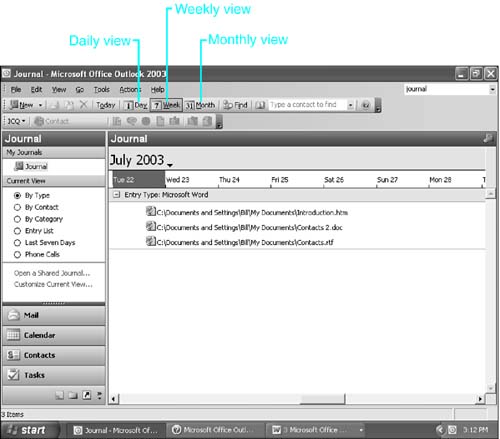Using Outlook with Word
Microsoft Outlook 2003, Microsoft Office's "personal information manager," is included in every version of Microsoft Office 2003. Outlook 2003 integrates with Word in three key ways that can make you more productive:
If you use Outlook as your email client software, you can edit your email with Word. This gives you access to Word's extensive formatting and proofing capabilities. You can also send a Word file as an attachment, using the File, Send To, Mail Recipient (as Attachment) command. Using Word as your email editor is covered in detail in Chapter 30, "Using Word as an Email Editor."
You can track your contacts in Outlook and use your contact information in a Word mail merge. (This is covered in detail in Chapter 17, in the section "Selecting an Outlook Contact List Containing the Names You Want to Use.")
You can track your Word documents through Outlook's Journal feature, making it easy to find out what files you worked on when, and for how long you worked on them. This is covered in the following section.
Tracking Word Progress in the Outlook Journal
Did you ever wonder how much time you spent on a particular document over a series of days? Or maybe you're looking for a particular file you worked on sometime last Wednesday in the afternoon, but now you can't find it or remember its name. Outlook's Journal feature can keep track of all your work in Word (and Excel and PowerPoint), recording exactly what you worked on, when you worked on it, and for how long.

From within Outlook, it's easy to see which entries, if any, currently appear in your Journal: choose Go, Journal. If the Journal folder doesn't appear, choose Journal from the list of options in your current view. You'll see a timeline of days at the top of the Journal window and filenames at the bottom (see Figure 29.26).
Figure 29.26. Word files tracked by the Outlook Journal.

You can choose a daily, weekly, or monthly timeline by clicking the appropriate toolbar button. Figure 29.27 shows a daily view. Each icon has a Duration bar above it to show when and for how long the document was open. By default, if you double-click the icon, the journal entry associated with the file opens. This journal entry contains information about the file, including exactly how long it was opened. It also contains a shortcut you can double-click to open the file itself.
Figure 29.27. The Journal shows how long you worked on a document and when.

You can also right-click the journal entry for a list of options. For example, Open Item Referred To opens the file the journal entry refers to, without the extra step of displaying the journal entry.
Working with the Journal Entry
An Outlook journal entry contains much more than a filename and date. To work with the journal entry, right-click it. From the shortcut menu that appears, choose Open Journal Entry. The file's journal entry appears (see Figure 29.28).
Figure 29.28. A Word file's journal entry in Outlook 2003.

Start Time shows when you started working with the file on that day. Duration shows how long the file was open. You can assign the file to a contact by clicking Contacts and selecting a name from your Outlook contact list. When you finish reviewing or editing the journal entry, click Save and Close.
TIP
You can open the Word file directly from within Outlook.
From the Journal window, right-click on the journal entry and choose Open Item Referred To from the shortcut menu. The Opening Mail Attachment dialog box appears; click Open It and click OK.
From within the Journal Entry dialog box, double-click on the file icon. The Opening Mail Attachment dialog box appears; click Open It and click OK.
TIP
To link a document to a specific contact, enter the contact name in the document's property keywords.
Controlling Whether Outlook Tracks Your Work
By default, the Journal tracking feature in Outlook is turned off. To turn it on, or to make sure that it is still turned off, follow these steps:
Open Outlook.
Choose Tools, Options.
If the Preferences tab isn't already open, click Preferences to display it.
Click Journal Options. The Journal Options dialog box appears (see Figure 29.29).
Figure 29.29. Changing the way Outlook tracks your work in Word.

In the Also Record Files From box, check or clear the check boxes next to Microsoft Word and any other Office program you want Outlook to track or to stop tracking.
Click OK.
After you turn on tracking, Journal tracks your work whether or not you open the Outlook application.







